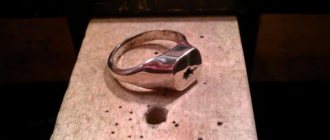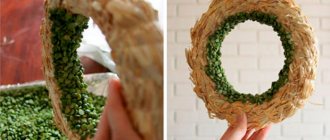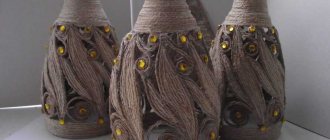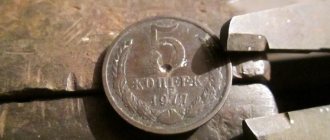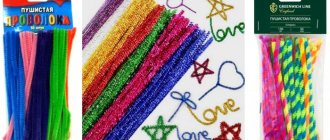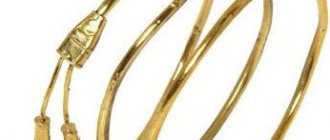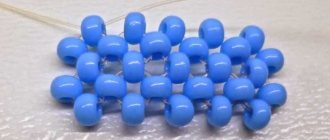dolio.ru » Handmade » Jewelry » DIY wire ring: MK for beginner craftsmen
Making wire jewelry is quite a difficult and complex task. To make them, sometimes you need to spend more than one meter of wire and many hours of free time. But their beauty and uniqueness fully compensate for all the labor costs incurred by masters of handmade accessories.
Although beginners in this business should not be afraid in advance. In fact, there are several very simple and easy ways to make an original decoration in just a couple of hours. For example, it could be a DIY wire ring, which you can create even without much experience.
Method I (very simple). Simple wire ring
To make it you will need the following materials :
- 7-13 cm of soft or semi-hard wire No. 16, 18 or 20 (it all depends on what kind of ring you want to make)
- nippers or side cutters
- round pliers
- a round tube or any other similar base on which a ring of the desired diameter can be formed
Progress:
- Cut the wire to the required length (it depends entirely on what diameter ring you need and what pattern you will make from the wire):
- At each end of the wire, use pliers to bend loops of the same size:
In this case, they should be bent in different directions:
Master class No. 2
Such an elegant ring will decorate any outfit; you just need to choose matching ribbons.
- rubber tube clamp;
- two ribbons of contrasting colors;
- thin gold elastic (you can use a hair elastic);
- pearl;
- scissors;
- hot glue gun;
- threads;
- screwdriver.
Loosen the nut on the clamp and increase the size of the ring. Please note that after you wind the ribbon, its diameter will decrease, so leave a sufficient margin.
Take one of the colored ribbons and use glue to secure it to the inside of the ring. Wrap the tape diagonally around the ring, then try it on. It should be easy to put on and take off. Once you have wrapped the entire ring with tape, secure it with a drop of glue.
Attach the pearl: to do this, pass a needle and thread through the hole in the pearl, wrap it around the ring several times and sew it to the ribbon. Before tightening the loop, add a little glue to the pearl to help it stick.
Take a ribbon of a different color and fold it in half lengthwise. Glue one end of the ribbon to the ring. Fold the ribbon into a rose shape: to do this, lay the ribbon around the pearl, twisting it all the time. Hide the free end and secure with glue.
Cut the gold hair tie, hide one end of it in the folds of the ribbon and glue it. Wrap the elastic band around it, but don't tighten it too tightly. Also glue the free end, hiding it in the folds.
Method II (more complex). Curled wire ring
To make a ring that is more voluminous and complex in structure, you will need the following materials :
- from 17 to 26 cm of wire (in this lesson the master used red and brass wire)
- ruler
- wire cutters
- round pliers
- pliers
- needle nose pliers
- PVC pipe or any other round object whose diameter corresponds to the diameter of the future ring
- nylon mallet or leather-headed mallet
Progress:
- Using pliers, shape your wire into a U-shape by wrapping it around the very ends of the tool:
Moreover, it is not at all necessary that it bends exactly in the middle. You can make one end a little longer than the other. As a result, the ring will turn out very beautiful.
- Next, use pliers to make the U-shaped loop as flat as possible:
- Wrap the doubled wire around the round base and use a hammer to shape it into a ring:
Start tapping from the middle of the wire (from the U-shaped bend) and move towards the ends (but don’t touch them yet!). You need to be especially careful in the place where the double layer of wire ends and the single layer begins (if you hit it hard, it can simply break off). You should end up with something like this:
- Then remove your future ring from the base and shape the free ends into a spiral shape using pliers (and your own imagination):
- After this, return the ring to the base and tap it again with a hammer, including the middle and now curled ends. This will give it a nice rounded shape that will look natural on your finger, and will also make the wire harder and stronger.
The ring is ready! Now you can safely wear it or give it to someone close and dear to you.
Share
A ring made of aluminum wire and beads, lightweight in every sense. Master class for beginners
I bring to your attention a way to decorate and enliven your image, allow yourself to add decorations to your mood.
Wire work professionals are unlikely to find anything new on this page. But most of us can safely be called a jack-of-all-trades, and anyone can make such a ring while on vacation (remember: the best vacation is a change of activity?).
I learned everything I can make from wire “quietly with myself,” with books and the Internet. I have read all the master classes in this section and “Working with Metal” at least once, and some have worked with materials and tools in my hands. I learned by copying many products from photographs from every available source. I give away all the results of such “creativity”, wear them myself, and, of course, threw away some of them.
I saw a similar ring on the Internet and immediately understood how and from what I would make “this” for myself. Easy and fast.
I invite everyone to make a ring with me based on a photo of a master unknown to me (God grant him, no matter what they call you, (or her) happiness, health, buyers, admirers of talent, sales, new ideas and, of course, fun and joy! ), and in the process note all the advantages of the idea - both aesthetic and constructive: lightness, airiness, ventilation of the cast, reliability of fastening the bead with minimal effort, speed of production, this is simply the embodiment of my favorite mathematical rule “necessary and sufficient”.
Materials and tools:
- Aluminum wire for weaving with a diameter of 1 mm in a natural color that can safely be called silver. It was the first one that caught my eye and fell in love with it for its low cost, plasticity, neutrality to the skin, resistance to water, air, dishwashing liquid and other daily vicissitudes of fate, and, of course, extreme weightlessness (all of the listed properties in different situations can be assessed as as both advantages and disadvantages). In terms of softness, I can compare brass with aluminum, but “that’s a completely different story,” differing in price, in the prevalence/availability of the material, and in the properties of the finished item when used.
- A round bead with a diameter of 8 mm with a through hole with a diameter of 1.2 mm (that is, allowing it to be strung directly onto the wire); color, material, and, by and large, the shape and size of the bead can be very diverse, except for the diameter of the through hole, since an excessively loose hole will allow the bead to fidget without our permission, which may not be very beautiful and convenient. I had a round transparent faceted zircon bead.
- Nippers (from a plumber's kit, and I can vouch that manicure ones are wonderfully suitable for one-time work with aluminum wire of this thickness - they will bite everything they need and remain safe and sound).
- A needle file (at some point I only had a glass manicure file, it fully met my expectations, smoothing out the sharpness of the tip of the wire, and continues to serve me faithfully for its main purpose).
- We will need round-nose pliers (bought at a hardware store - they have almost everything a needlewoman needs, but 2-3 times cheaper than in specialized hobby stores) at the last moment for an addition that was not in the image that inspired me. Before purchasing them, I used straight-nose pliers from the “young household electrician” kit to achieve similar goals.
- Ruler.
Let's start by blessing ourselves.
We cut the wire to the required length: three turns around the chosen finger plus 3 cm for safety.
Aluminum wire is so plastic that bending it around a finger allows it to be used as a measuring instrument (they measured boa constrictors in parrots) without losing their presentation when unbent. In addition, such a homemade finger gauge can be moved along the finger, which will not be possible with a thread or a centimeter. Lovers of accuracy can use a centimeter or thread and a ruler. Those who are keen on accuracy and know their size can use the Correspondence Table and calculate the girth of the finger in mm.
This is the most detailed one I've ever seen.
| Ring diameter | Finger circumference (mm) | Ring sizes | ||||
| (inches) | (mm) | Russia/ Germany | England | USA | Japan | |
| 0.553 | 14.05 | 44 | 14 | F | 3 | 4 |
| 0.569 | 14.4 | 45.2 | 14 1/2 | 3 1/2 | ||
| 0.585 | 14.8 | 46.5 | 15 | H 1/2 | 4 | 7 |
| 0.601 | 15.3 | 47.8 | 15 1/2 | I 1/2 | 4 1/2 | 8 |
| 0.618 | 15.7 | 49 | 15 3/4 | J 1/2 | 5 | 9 |
| 15.9 | 50 | 16 | K | 5 1/4 | 9 | |
| 0.634 | 16.1 | 50.3 | 16 1/3 | L | 5 1/2 | 10 |
| 16.3 | 51.2 | 16 1/2 | L | 5 3/4 | 11 | |
| 0.65 | 16.5 | 51.5 | 16 2/3 | M | 6 | 12 |
| 16.7 | 52.5 | 17 | M | 6 1/4 | 12 | |
| 0.666 | 16.9 | 52.8 | 17 1/9 | N | 6 1/2 | 13 |
| 17.1 | 53.8 | 17 1/4 | N | 6 3/4 | ||
| 0.683 | 17.3 | 54 | 17 1/2 | O | 7 | 14 |
| 17.5 | 55.1 | 17 3/4 | O | 7 1/4 | ||
| 0.699 | 17.7 | 55.3 | 17 8/9 | P | 7 1/2 | 15 |
| 17.9 | 56.3 | 18 | P | 7 3/4 | ||
| 0.716 | 18.2 | 56.6 | 18.3 | Q | 8 | 16 |
| 18.3 | 57.6 | 18 1/2 | Q | 8 1/4 | ||
| 0.732 | 18.5 | 57.8 | 18 2/3 | Q 1/2 | 8 1/2 | 17 |
| 18.7 | 58.9 | 19 | R | 8 3/4 | ||
| 0.748 | 18.9 | 59.1 | 19.1 | R 1/2 | 9 | 18 |
| 19.1 | 60.2 | 19 1/3 | S | 9 1/4 | ||
| 0.764 | 19.3 | 60.3 | 19 1/2 | S 1/2 | 9 1/2 | 19 |
| 19.5 | 61.4 | 20 | T | 9 3/4 | ||
| 0.781 | 19.8 | 61.6 | 20 1/4 | T 1/2 | 10 | 20 |
| 0.798 | 20.2 | 62.8 | 20 1/3 | U 1/2 | 10 1/2 | 22 |
| 20.3 | 64 | 20 3/4 | V | 10 3/4 | ||
| 0.814 | 20.7 | 64.1 | 21 | V 1/2 | 11 | 23 |
| 21 | 65.3 | 21 1/4 | W | 11 1/2 | 24 | |
| 0.846 | 21.2 | 66.6 | 21 3/4 | W 1/2 | 12 | 25 |
| 0.862 | 21.9 | 67.9 | Z | 12 1/2 | 26 | |
For example, according to this table, for size 20 the ring diameter is 19.5 mm. Plus to the diameter of the ring we will add half the diameter of the round bead - I have 4 mm, since it is put on the rim of the ring, it is already 19.9 mm, and to be sure, we will round the diameter up and select a line of size 20 and 1/3 and look at the circumference in it finger - 62.8 mm.
We count: 3*62.8+30=218.4 mm = 21.8 cm
In the finished form, we have 2.5 turns of wire around the finger, of which 2/6 turns are spirals securing the structure, and 1/6 turn are arcs of the second turn of wire around the bead, they will “eat up” the additional length. I don’t recommend increasing the length of the wire further - the softness of the material will allow us to easily make turns at the last stage, but it will also contribute to prematurely crushing the base of the ring with excessively long tails.
Total: 22 cm is enough even for the most careful and prudent.
I’ve been writing for the second hour and I’m having a lot of fun - shouldn’t I add more time, because it will take longer to read all this than to do it. As a dear teacher once told us: “Now I’ll tell you about this in more detail, in a nutshell.” Eh!
Having measured seven or seven times, we cut off the wire, string a bead on it and move it to the middle of the piece of wire.
Next, we begin to carefully round the wire, crossing its ends, as we do with the ends of a scarf, wanting to tie a knot at the back of the head.
And tighten the loose loop, approximately to the size of the future ring.
It’s more convenient for me to do this by weight, and then trim it on my finger. For perfect evenness of the ring rim, you can use any cylindrical object, for example, an often-used lipstick, a battery, a felt-tip pen or a spool of thread.
Now we carefully try the blank on the finger chosen for decoration with a new ring, with the bead facing up.
The ends of the wire are located on different sides of the first turn, and therefore on different sides of the bead - the far one is closer to the base of the finger, the other is closer to the nail. We tilt them towards each other, smoothly bending around the bead in an arc at a distance of 2-3 mm.
And we place the rings on top of the two main turns of the rim at an angle of about 45 degrees to the rim.
As you can see, it is directed in both directions along the free end of a wire approximately 2 cm long (comparable to the diameter of the ring),
with which it is easy to make 2-3 free parallel turns around the rim of the ring. The softness of the wire allows you to do this directly by weight, holding the turns of the rim with your fingers.
We bring the outermost turn out, that is, into the space between the fingers, bite off the excess and easily smooth out the sharpness of the cut with a file or file so that the wire does not scratch the skin. Press the outermost turn tightly against the rim of the ring.
We repeat these steps on the other side. In fact, after biting off a piece of wire with wire cutters, I sculpt the entire ring with my hands, taking advantage of the exceptional pliability of the material.
For dessert, the most delicious thing is to decorate the arcs around the bead with dents, which will create a sparkling effect, add a little shine to the ring and surround the bead with additional shine. I make dents by lightly squeezing the wire with pliers at a distance of 1-2 mm from one another.
This effect happened by accident: trying to adapt, instead of round nose pliers, the outer side of metalworker's narrow nose pliers, inside of which there is a corrugated surface,
I accidentally squeezed and scratched a section of the finished cuff, sealing the fastening of the bead, and decided to “bite” the entire curl around it. The dents made by narrow nose pliers are less deep and more uniform than those made by round nose pliers.
I liked the result so much that I use this technique quite often.
In addition, such “faceted” processing gives the wire rigidity and elasticity, which is pleasant when using jewelry. The softness of the material pleases us more while working than when wearing jewelry.
Oh! I got sick!
You can already put on a light, airy new ring and go to a feast, and to the world, and to good people!
a ten-meter skein of wire (these are the pieces that are sold all around) and a handful of beads of any origin will allow you to acquire 45 rings for all outfits, occasions and moods, seasons, dreams and other various circumstances that you want to become more in tune with outside, and not just inside. Or make happy a crowd of teenage girls, who are increasingly difficult to lure into reality from virtuality, with a fun master class and new clothes. Using painted aluminum wire will open up an almost endless field of options for playing with color and shape, warmed by the knowledge of a minimal investment of time and money.
For example, in a mood of restraint and a desire for pastel shades and laconic solutions, I tried the option with a matte bead, and flattened the arcs around it with pliers and then slightly bent them into waves using the tips of the round nose pliers. Like this:
It should be mentioned that when squeezed with pliers (especially when beaten with a hammer), aluminum wire loses its glossy shine and becomes matte, however, let me clarify that in such circumstances my painted wire never peeled off, it just stopped shining.
Mark Twain, I remember, wrote that if there is no way to use the fail-safe “and then they got married, lived happily ever after, and died on the same day,” stories should end in the most convenient place. For example, here.
The simplest device for twisting wire rings
What are wire rings used for anyway? You can weave a chain from wire rings, use them as sinkers in making nets, make stoppers, or as patterns in decorative metal fences and window grilles. Yes, you never know for what. It all depends on the thickness of the wire and the metal from which it is made: iron, aluminum, copper, nichrome... And of course, on your imagination.
The simplest device for twisting wire is made in a home workshop
Two pieces of pipe are welded onto a long strip, one at each end. They will play the role of landing bearings. Plates are welded between the tubes and the strip, thanks to which the gap increases, which is so necessary to be able to wind wire of different thicknesses.
According to the length of the base strip and the inner diameter of the tubes, another pipe was selected, onto which wire rings were screwed. In this pipe, up to about half its length, a longitudinal cut was made using a grinder. A handle is welded to the opposite end of the pipe, where there is no cut.
That's the whole design
How to work?
First, the device must be installed in a vice. Next, we insert the end of the wire, which we will twist into rings, into the longitudinal section of the pipe, and begin to rotate the pipe with the handle.
The wire is twisted into rings. After the wire is twisted, we move the pipe to the side so that one end comes out of the landing tube, and remove the twisted wire.
Now all that remains is to use a chisel and a hammer to cut the twisted wire into separate rings!
zen.yandex.ru/id/5b238e7171f78e00ac9570f6/
Making a ring from twisted wire
First, we take our improvised crossbar (that is, a cylindrical object) and tightly wind the wire onto it three times. In this case, you need to ensure that as a result of this operation the “tails” are approximately the same length. After winding, the “tails” need to be intertwined with each other, pulling the wire quite tightly.
Now we begin to form the “whirlpool” itself. We align the turns so that they lie parallel and fit closely to each other, then we twist the ends of the wire even more tightly.
We continue to twist, holding the top with a finger so that the “whirlpool” is flat. This requires some skill and may not work out right away, but we do not retreat from difficulties!
When the “whirlpool” grows to the desired size, leave the free ends perpendicular to the rim of the ring.
We remove the ring from our cylindrical object and begin to wrap the “tails” of the wire around the rim.
Be sure to press each turn with duckbills, but carefully and gently so as not to leave dents on the wire.
When there are three lines, the ends of the wire need to be cut with wire cutters. We leave only very short pieces, approximately the width of the rim of the ring, and treat them with natfil so as not to prick your finger. We approach this task responsibly and smooth the ends until they are round.
We bend these rounded “tails” with duckbills onto the wrong side of the rim and press them well.
This is roughly what it should look like from the inside out. If the “whirlpool” turns out to be too convex for your liking, you can also press it in with platypuses. But carefully! It is very easy to scratch the wire.
Now the ring is ready. You can try it on! And wear it with pleasure. Generally speaking, to give a piece a more finished look, it should be patinated and polished. But this is a broad topic and, perhaps, for a separate master class.
Popular articles Ideas for restoring an old cabinet with your own hands
Thank you for your attention to my MK, and look into my workshop “Gifts of Lempo” for interesting things, ideas and inspiration
What is needed for the job?
Before you start creating a craft, you need to prepare all the materials that may be needed during work. The material, of course, depends on the type of craft. In addition to the wire itself, we can talk about multi-colored threads, beads, sequins, beads. Fabric scraps with beautiful patterns, foil and colored paper can also come in handy. Additionally, it is worth preparing such natural materials as roots and branches of plants of unusual shapes. Plasticine will not be superfluous. In addition to copper wire, you can additionally use other types of wire with different thicknesses in order to be able to make the frame thicker and the parts and connections thinner.
You will need wire cutters to obtain wire pieces of the required size, and round nose pliers and pliers will allow you to give them a beautiful bend. Quite often, creating bulk copper crafts requires a soldering iron to connect key parts. Since it is not possible to hold the hot wire with your bare hands, you should first prepare tweezers, at least ordinary (medical) ones.
A combination of a hammer and anvil will allow you to add the necessary flattened parts to the product. The role of an anvil can be played by some large metal object with a flat surface. Other tools required for working with copper wire include sandpaper, scissors, and durable tape.
Recommendations
To ensure that the chosen product is successful, we recommend that you first watch training master classes, where all training takes place from scratch. Easy training lessons, which show the principle of working with copper wire, will help you understand the essence of working not only with the material, but also to master the technology of weaving.
We recommend paying attention to the variety of techniques for creating jewelry. One of the popular techniques for wire weaving today is Wire Wrap.
Usually, using this technique, various stones and crystals are braided. Pendants, brooches and earrings look very elegant here. The Wire Wrap technique can be easily mastered by studying some videos at home, after which your favorite hobby can become a full-time job.
Below you can see a full review.
A little complicated, but at the same time very exciting, is the Viking Knit weaving technique. With its help you can create original openwork neck jewelry, as well as bracelets and earrings.
When creating jewelry, you should not be afraid to experiment in search of something new. But this is only possible if you have basic skills in weaving jewelry and, of course, a great desire to learn. The workplace should always be in order and have good lighting - only then will it be possible to do this work with great pleasure and comfort.
How to roll wire into rings?
To make a simple bender for rolling wire into rings, you will need very few materials.
The tube is 25 mm in diameter. We saw off a 60 mm long piece from it.
From one end of the segment we make an end cut along the tube. The length and width of the cut are 40 x 5 mm.
We're done with the tube, now we'll work on the base plate.
The size of the base plate is 40 x 120 mm. We saw off this plate from a steel strip of the appropriate size.
We install the tube on the plate vertically, in its center, with the sawn end up.
We weld the plate with the tube.
On the workbench, select a free space for the twister. We try to place it near the edge of the workbench, so that it is convenient to work.
We can work.
The process of twisting wire into rings is simple. One end of the wire must be inserted into the longitudinal section of the tube, thereby hooking it onto the tube. Next we wrap the wire around the tube.
When the wire is wound around the tube, remove it through the top of the tube, pull it by hand, and the spring from the wire rings is removed.
Using wire cutters, cut the wire into individual rings.
The simplest device for twisting wire rings
What are wire rings used for anyway? You can weave a chain from wire rings, use them as sinkers in making nets, make stoppers, or as patterns in decorative metal fences and window grilles. Yes, you never know for what. It all depends on the thickness of the wire and the metal from which it is made: iron, aluminum, copper, nichrome... And of course, on your imagination.
The simplest device for twisting wire is made in a home workshop
Two pieces of pipe are welded onto a long strip, one at each end. They will play the role of landing bearings. Plates are welded between the tubes and the strip, thanks to which the gap increases, which is so necessary to be able to wind wire of different thicknesses.
According to the length of the base strip and the inner diameter of the tubes, another pipe was selected, onto which wire rings were screwed. In this pipe, up to about half its length, a longitudinal cut was made using a grinder. A handle is welded to the opposite end of the pipe, where there is no cut.
That's the whole design
How to work?
First, the device must be installed in a vice. Next, we insert the end of the wire, which we will twist into rings, into the longitudinal section of the pipe, and begin to rotate the pipe with the handle.
The wire is twisted into rings. After the wire is twisted, we move the pipe to the side so that one end comes out of the landing tube, and remove the twisted wire.
Now all that remains is to use a chisel and a hammer to cut the twisted wire into separate rings!
Ring with semi-precious and precious stones
If you are still wondering how to make a ring from wire and none of the options proposed above appeal to you, then you will definitely be delighted with this decoration. If you have several beautiful and small natural stones, you just need to turn them into a beautiful ring. It’s good if there is already a hole in the stone, for example, if it was left over from another piece of jewelry. But you can simply glue the stone in the center of the product. All the initial work follows the steps of creating a champagne wire ring. But for this product it is better to take very thin copper or gilded wire and fold it not twice, but three or four times. Then the loose ends need to be twisted around the stone.
DIY wire wrap jewelry. Copper wire for pendant.
For this pendant I used 1mm and 0.4mm thick copper wire. I bought the wire at an electrical goods store. Where they sell electrical wires.
I go to the store with a caliper so as not to “miss” the thickness of the wire. The store will tell you the cross-section of the wire and not its actual thickness. Section and thickness are not the same thing! At home I cut the wire into pieces and remove the braid. It turns out cheap and cheerful. I have a store nearby - you can buy copper wire at any time.
Popular articles Decorating candles
If you already have copper wire of the required thickness in coils or you decide to buy one in an online store - GREAT! The only caveat is that there should be no varnish on the wire!
You can see different wires in the Russian online store – https://prodiel.ru/
